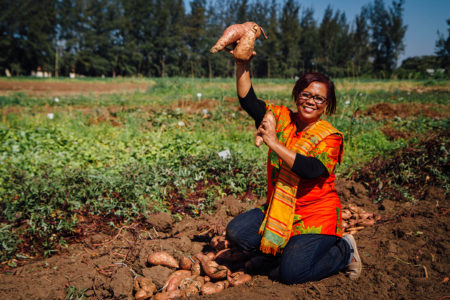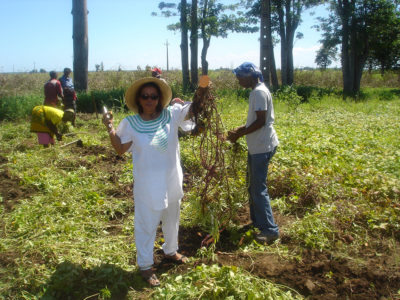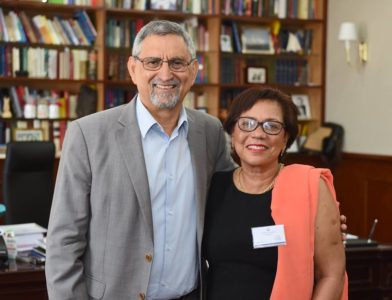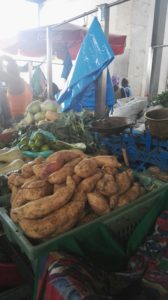
At restaurants across Cape Verde, Maria Andrade is on the menu. Baked, boiled or fried, the Maria Andrade sweetpotato serves up more than just flavor. It delivers enough micronutrients to protect against the most pernicious form of hidden hunger, vitamin A deficiency (VAD). Often served as a side with fish or meat, the tasty orange flesh of drought-resistant sweetpotato, has become synonymous with its namesake the World Food Prize-winning sweetpotato breeder, Dr. Maria Andrade.
“Even if I’m not living in my own country, the result of my life’s work is having a spillover effect,” says Andrade. “I enjoy seeing the orange at the table. The Maria Andrade sweetpotato, my sweetpotato, is being grown and eaten. The people of (Cape Verde) value it and consider it healthy.”

Climate-smart sweetpotato takes root

For more than two decades Cape Verde’s native daughter has been working tirelessly to get sweetpotato into the hands of drought battered farmers. In the span of five years (2011-2016) alone, Andrade and her Mozambique based team released 22 drought-tolerant sweetpotato varieties through the International Potato Center (CIP for its acronym in Spanish) that are now grown as far off as Abu Dhabi and Bangladesh.
On the islands of her childhood the crop has really taken root since 1986 when it first piqued Andrade’s interest. Back then sweetpotato was given little thought by breeders or farmers, despite the fact that in times of drought the roots produced while other crops withered.
“Cape Verde is located in the Sahel desert and even so farmers planted maize year after year,” says Andrade as she remembers watching families grow hungry over lost harvests. “The yields are low. I wanted to look into a crop that was new. That could be a solution to drought.”
Andrade was working at a research center at the time and lobbied her bosses to bring an agronomist from Brazil to visit and share his knowledge of root crops. He came for a month and by the end she was smitten. “I worked on sweetpotato every day,” she says. “I fell in love with how fast it grew. Farmers have something to eat 60 days after planting.”
The following year she moved west in pursuit of a doctoral degree at a program with a focus on sweetpotato.
Gleaning inspiration from North Carolina
Sweetpotato planting near North Carolina University is in the thick of summer. Andrade remembers the intense June heat beating down on her as she surveyed the damp fields. “You don’t have to make any effort to grow sweetpotato in North Carolina,” Andrade says of the abundant growth. “I thought to myself, this is what I want. In my country we can’t grow anything. I want this, what I see right here.”
Over the years Andrade refined her work, breeding for specific traits that help sweetpotato thrive in extreme conditions. A thicker stem allows for more water absorption. Smaller leaves mean less water is lost through transpiration. Abundant canopy coverage seals in soil moisture. Her work has helped Mozambicans recover from floods and feed their families in times of extreme drought. To date more than 4.19 million people worldwide now have access to climate-resilient sweetpotato thanks to the efforts of plant scientists like Andrade.
Breeding the perfect sweetpotato, however, is not enough if farmers aren’t interested in what you offer. A trip to the annual Sweetpotato Festival got Andrade thinking about ways to entice people to the virtues of her favorite root. Along with the standard festival rides, contests, and displays was a stapled together recipe book with more than 36 sweetpotato dishes including desserts and purees—a major departure from the standard boiled and roasted sides of Andrade’s childhood. Not only can sweetpotato grow anywhere, Andrade was seeing that it was just as versatile for home cooking.

The sweet that brings health

In 1996, Andrade’s passion for sweetpotato drew her to Mozambique. It was there she learned that 69 percent of Mozambican children were deficient in vitamin A. Despite supplementation projects, those living in the most remote villages were not being reached. Andrade knew that Mozambicans could grow their own medicine by adopting orange-fleshed sweetpotato (OFSP) as a crop. The question was how to make it happen.
Local women only knew how to boil and roast sweetpotato. Inspired by what she saw in North Carolina, Andrade’s team began creating recipes with readily available ingredients. For example, in areas where the cost of sugar was prohibitive, the team looked for substitutions such as the abundant sugar cane stalks growing around the village.
Since a lot of the women had limited education, the project turned to social marketing strategies to increase engagement. Orange skirts with colorful reminders on the importance of OFSP consumption turned the recipients into walking billboards, while messages were reinforced via the radio and street performances.
When major floods devastated sweetpotato crops in the year 2000, Andrade’s team took it as an opportunity to help farmers re-establish the food supply with fast-growing OFSP replacing the traditional less nutritious white-fleshed varieties. Almost 20 years later OFSP has become the go-to crop in Mozambique to help farmers recover from catastrophes and fortify children against the ravages of vitamin A deficiency
OFSP is now known as the “sweet that brings health.” Its eye-catching color is a brand of its own. A concept that Andrade’s team cements by drenching their cars, brochures, and even their wardrobes in the trademark hue.
A new approach to testing markets
Nowadays if Andrade wants to test how entrenched OFSP is in the Mozambican diet, she needs to look no further than the local market. A favorite pastime is to masquerade as an unknowing customer.
“I go to the market and I argue with the vendors,” she says and points at the white-fleshed varieties. “I want the white one, those orange ones are funny looking.” Time and time again the vendors argue back. “
“You don’t know what you’re saying,” they tell her and offer up OFSP instead. “This is what I feed to my children. Don’t eat the other one. It has no vitamin A.”
For Andrade, knowing that OFSP is helping farmers worldwide fulfills the dreams of her youth. “My work in sweetpotato means that people don’t have to go to sleep without dinner,” says Andrade. “It feels good. We can’t do everything, but we do whatever we can to reduce the suffering of one or two people.”
Dr. Maria Andrade is a sweetpotato breeder based out of Mozambique. She is co-recipient of the 2016 World Food Prize and recently won the M.S. Swaminathan Award for Environment Protection for her innovative work to help combat micronutrient deficiency and food insecurity with biofortified orange-fleshed sweetpotato.
